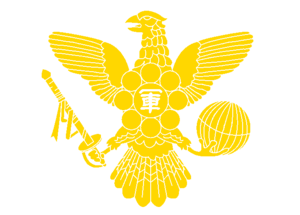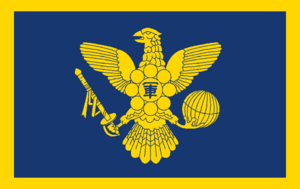Republic of Zhenia Defense Forces: Difference between revisions
(Created page with "{{Infobox national military | name = Republic of Zhenia Defense Forces | native_name = 진화민국 국군 | image = GEUDEF Emblem.png | alt...") |
mNo edit summary |
||
| Line 15: | Line 15: | ||
| headquarters = [[Hall of War]], [[Daedo#Adminstrative Districts|Sudo district]], [[Daedo]], [[Zhenia]] | | headquarters = [[Hall of War]], [[Daedo#Adminstrative Districts|Sudo district]], [[Daedo]], [[Zhenia]] | ||
| flying_hours = | | flying_hours = | ||
| website = www. | | website = www.rzdf.mil.zhen | ||
<!-- Leadership --> | <!-- Leadership --> | ||
| commander-in-chief = [[Lee Saemin]] | | commander-in-chief = [[Lee Saemin]] | ||
Revision as of 04:03, 5 April 2020
| Republic of Zhenia Defense Forces | |
|---|---|
| 진화민국 국군 | |
 Emblem | |
 Military Flag | |
| Motto | "Beyond the Frontier" |
| Founded | 1868 |
| Current form | 1955 |
| Service branches | Republic of Zhenia Army Republic of Zhenia Navy Republic of Zhenia Air Force Republic of Zhenia Marine Corps Republic of Zhenia Strategic Forces |
| Headquarters | Hall of War, Sudo district, Daedo, Zhenia |
| Website | www.rzdf.mil.zhen |
| Leadership | |
| Supreme Commander of the Defense Forces (Daewonsu) | Lee Saemin |
| Secretary of Defense | Jaeyeon Eo |
| Personnel | |
| Military age | 18 |
| Conscription | 3 years minimum; varies by branch |
| Available for military service | 18,318,134 males, age 18-25 (2019), 17,556,818 females, age 18-25 (2019) |
| Fit for military service | 12,842,429 males, age 18-25 (2019), 8,711,414 females, age 18-25 (2019) |
| Reaching military age annually | 2,142,002 males (2019), 2,174,735 females (2019) |
| Active personnel | 1,560,000+ active personnel |
| Reserve personnel | 2,100,000 combat reserves 14,000,000 wartime reserve personnel |
| Deployed personnel | 56,000 |
| Expenditure | |
| Budget | $480.1 billion |
| Percent of GDP | 3.5% |
| Industry | |
| Domestic suppliers | Zhenia |
The Republic of Zhenia Defense Forces (RZDF) (Zhenian: 진화민국 국방군) refers to the combined military force in Zhenia. Primarily consisting of five branches - the Army, Navy, Air Force, Marine Corps and the Strategic Forces - it is one of the largest military forces in the world today, standing at 1,560,000 active personnel. Its administrative headquarters are located in the Hall of War in the Sudo-gu district in Daedo, although its wartime command headquarters are located in the Zhongwu Citadel, located around 140 kilometers east of Daedo. Although its commander-in-chief is the Chancellor of the Republic of Zhenia, it is headed by the Commander of the Defense Forces (Zhenian: 원수; Wonsu), while it is administered by the Ministry of Defense.
The Republic of Zhenia Defense Forces was created by the reorganization of the Imperial Zhenian Armed Forces on December 2, 1909, a day after the establishment of the Republic of Zhenia. Ranks, insignia and almost all of the Imperial Zhenian Armed Forces were almost completely absorbed into the new Republic of Zhenia Defense Forces, although the position of Wonsu, originally held by the Emperor, was elevated to Daewonsu and given to the Chancellor while the rank of Wonsu persisted as an honorary title. The Republic of Zhenia Defense Forces played a prominent role in Zhenia's involvement during both Great Wars; although it was temporarily disbanded during the Second Republic, it was quickly restored for security purposes. In 1956, then-Chancellor Kim Shimin announced a series of military reforms to restructure the GEUDEF's framework into what it is today - primarily a five-branch system distinguished by their domain of warfare, ultimately headed by the Commander directly appointed by the Chancellor. Its command structure was finally adjusted through a series of revisions in the 1980s amid the establishment of the Joint Special Operations Command.
Although it started out as a force of conscript soldiers, the Republic of Zhenia Defense Forces is an all-volunteer force, drawing its personnel from a pool of volunteer troops and only allowing conscription in wartime or other emergency situations. For such reasons, the Ministry of Defense retains the right to conscript soldiers and mandate all Zhenian men and women to be subject to the National Military Fitness Assessment tests at ages 18-25. Officers in all branches of the GEUDEF can be selected during their three years of minimum years of serving as soldier or through the cadet program in the nation's five military academies.
History
Structure
Command Structure
Organization
Service Branches
Army
The Republic of Zhenia Army (GEUA) is the primary ground force of the GEUDEF, with around 856,561 active personnel, constituting almost a half of the personnel in the GEUDEF. It is also historically the oldest branch of the GEUDEF alongside the Republic of Zhenia Navy, directly succeeding the Imperial Zhenian Army upon the establishment of the Greater Easter Union in 1909. It can be reinforced by reserve forces in wartime, with its 1,200,000 combat reserve personnel mostly centered around defense-oriented divisions.
Unlike other service branches, the Republic of Zhenia Army was traditionally the only military branch in which conscription took place - that is, when the conscription system was existent, Zhenian recruits were sent to the Army if they did not intentionally choose other branches. Such conscription has been abolished, however, with the advent of the Fourth Republic in 1979, which in principle prohibited non-emergency conscription across all branches of the GEUDEF; since then, the Army consists of an all-volunteer force like all other branches.
The Republic of Zhenia Navy (GEUN) is the naval warfare service branch of the GEUDEF, standing with around 326,000 active personnel as of 2020. With its roots directly at the Imperial Zhenian Navy during the Empire of Zhenia, the Republic of Zhenia Navy was established with the reorganization of the Imperial Navy into a command system under the Chancellor and the Ministry of Defense. With its roles starting from the protection of the Union's interests in both domestic and international waters alike, it has expanded to become a core component of the nation's military power projection.
With 320 active ships in service, it has the largest fleets by tonnage in the world as well as the region. While it has an array of installations within Zhenia, it also retains numerous international bases to expand its range of operations abroad, with the most notable cases being Port Daesan in Euria and Port Aso in Toloria. The Navy is primarily commanded by the Commander of the Navy, who oversees the Board of Admiralty alongside the Navy Chief of Staff and assumes his duties as Chief of Naval Operations.
Air Force
The Republic of Zhenia Air Force (GEUAF) is the aerial warfare service branch of the GEUDEF, standing with around 338,000 active personnel and over 4,500 manned aircraft. Originally the Air Wing of the Republic of Zhenia Army, it became an independent branch of the GEUDEF in 1922 during the 1922 Military Reforms, assuming various roles including close air support, intelligence and interception and expanding onto air superiority, strategic strike and airlift in later years.
Marine Corps
A direct deputy branch to the Navy, the Republic of Zhenia Marine Corps (GEUMC) is a military branch specifically designated for expeditionary and amphibious operations in enemy territory, although its secondary roles include being a rapid response force and a strategic reserve. Although often considered the fourth branch of the GEUDEF, its command structure is formed under the Navy and often operates in tandem with the Navy.
Strategic Forces
The Republic of Zhenia Strategic Forces (GEUSF) is the military branch dedicated to controlling the GEUDEF's strategic assets, including intercontinental ballistic missiles and (thermonuclear) nuclear warheads. Although its exact composition remains a secret, there are speculations that they consist of 160,000 personnel with over 2,800 nuclear warheads. Formed with multiple missile divisions armed with intercontinental ballistic missiles and conventional ballistic and cruise missiles with ranges over 1,500 kilometers, its primary task is focused in both preemptive and retaliatory strikes on an enemy's offensive nuclear weapons, military facilities and industrial infrastructure, essentially disabling the enemy's capacity to wage war in the beginning. It forms one axis of Zhenia's nuclear triad alongside the Air Force's Long-Range Air Strike Command and the Navy's nuclear-powered ballistic missile submarine fleet.
While the traditional role of the Strategic Forces was focused on managing the nation's nuclear arsenal, its roles has expanded since the 1990s, into cyberspace and electronic warfare; the GEUDEF Cyberwarfare Command, among other commands, was established in 1999 specifically to fulfill such new roles. It has also been working with the Air Force in operating the Republic of Zhenia Space Command, which is said to expand the Air Force's operation sphere beyond the atmosphere. The Space Command is in charge of maintaining the nation's military rocket launch facilities as well as its military satellites and stations, including the Cheonseong Satellite System.
Secondary Commands
Doctrine
Personnel
Enlisted
Since 1979, the Republic of Zhenia Defense Forces no longer uses conscription as a method to fill its ranks, with the exception of certain circumstances including wartime; instead, it is maintained as an all-volunteer force consisting of service members recruited after high school graduation or during college years. Still, all Zhenian citizens ages between 19 and 35 are subject to the annual National Military Fitness Assessment exams, which evaluate one's prospect and potential in serving in the GEUDEF should such circumstances requiring conscription ever occur. All volunteers who intend to serve in any branch of the GEUDEF must take the National Military Fitness Assessment exams no further than one year before they apply to their desired branch of service. Although the maximum age for military service entry as an enlisted solider varies, the minimum age for initiating military service is 19 for all GEUDEF service branches.
After the application to the designed branch of service is made, each application is evaluated by the Ministry of Defense to determine the applicant's fitness to not only the particular service branch but also the Defense Forces at all - most applicants deemed 'unfit' can be screened in this process, if the National Military Fitness Assessment fails to screen them. If the applicant is deemed fit for military service in the said service branch, the applicant, now a prospective service member, undergoes 3 months of Initial Military Training (IMT), during which one acquires the basic skills needed to serve in the Defense Forces. Service Aptitude Training, the length of which can vary by service branch but normally lasts for 2 to 4 months, follows Initial Military Training.
Officers
Reserve Forces
After completing their active military service (which varies from branch to branch), both enlisted soldiers and officers become part of the Republic of Zhenia Reserve Forces.
